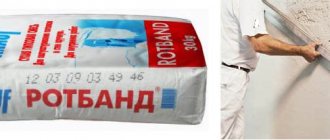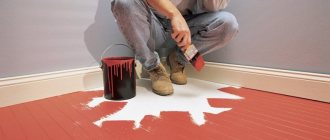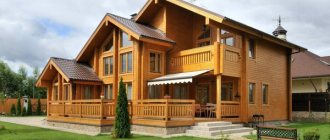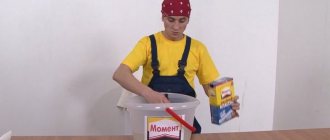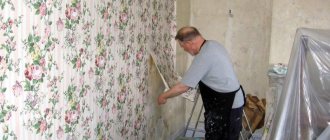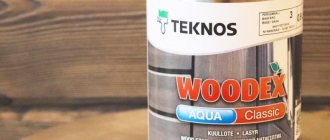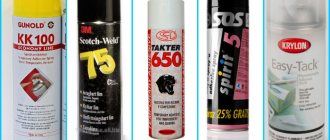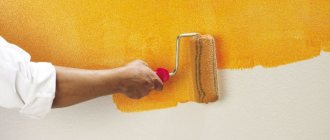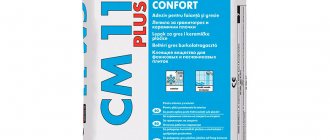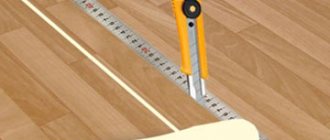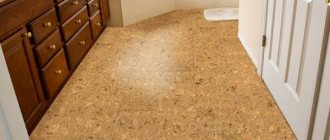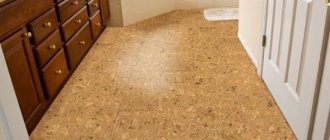In most cases, home renovations involve replacing old trim, flooring, wiring or wallpaper. In the latter case, owners quite often decide to install vinyl wallpaper. However, it should be understood that this procedure is quite labor-intensive and complex, since it is necessary to apply several layers of finishing equipment to properly connect the decorated part with the base material.
These wallpapers have quite an impressive mass. If you choose the wrong glue, then in the end the procedure will be performed poorly and will have to be repeated again.
If you do not have experience in installation work, it is better to immediately invite a specialist. However, it is worth noting that the result is influenced not only by the skill of the worker, but also by the quality of the finishing material. Therefore, it is recommended to buy the best vinyl wallpaper adhesive that is proven to be effective and reliable. In 2022, you can highlight a whole range of high-quality products from different manufacturers. It is recommended to study the rating, which will allow you to understand which adhesive for vinyl wallpaper is better.
How to choose wallpaper glue
Previously, there was only one glue - the one we cooked ourselves. And now it’s very easy to get confused in the variety of compounds and their manufacturers. There are also powdered products that need to be mixed in water yourself.
There are also ready-made materials. And there are even wallpapers that have a self-adhesive side. There are also significant differences in the chemical composition. Some brands have a pronounced unpleasant odor, but their adhesive qualities are excellent. Others smell almost nothing, but, unfortunately, have a weak hold.
In any case, when choosing glue, you should consider:
- Material of walls and wallpapers themselves;
- Approximate weight of the canvas;
- Environmental impact on wallpaper (air humidity, exposure to sunlight, etc.);
- Adhesion of the material to surfaces before and after drying;
- The ability to slightly move the wallpaper on the wall after applying the sheet;
- Environmental friendliness;
- Protection from moisture and fungal formation;
- Color and transparency of the composition, otherwise yellow stains may appear;
- Duration of use;
- Properties when exposed to moisture;
- Possible expense on different bases.
All of these factors are closely related to the chemical composition, so it needs to be considered first.
The best compositions for glass wallpaper
The wall covering is based on fiberglass and paper. The characteristics are similar to non-woven ones, but less plastic. They are glued using a special solution.
Oscar
Average price of goods: 1990 rub.
Advantages:
- no unpleasant odor;
- balanced price-quality ratio;
- practicality.
Flaws:
- none.
The solution is sold in finished form. No change in consistency or increase in volume is expected. The main purpose is to glue the fiberglass coating. Supplied to retail outlets in 10 liter buckets. Smaller containers are not provided.
This is an ideal option not only for glass wallpaper, but also for working with textile wall coverings. The main advantage is durability. The quality of gluing is excellent. The coating will last on the wall for decades.
Kleo Ultra
Average product price: 620 rub.
Advantages:
- versatility;
- functionality;
- practicality;
- economy.
Flaws:
- none.
A fairly reasonable price for such a product. The form is powdery, so dilution with water is required. The weight of the package is 500 g, which is enough to prepare 10 liters of solution. A distinctive feature is that it is completely indifferent to dyes for glass wallpaper. It is extremely popular.
Composition of wallpaper glue
The actual chemical composition of all wallpaper adhesives is approximately the same. Their characteristics differ due to changes in proportions.
Adhesive includes:
- Cellulose base (from 50 to 95 percent): MC, CMC, GPC or KMC;
- PVA (from 5 to 50 percent): increases adhesive and moisture-resistant characteristics;
- Antiseptic substances (3-4 percent): resist fungal and mold formations.
When choosing an adhesive, you need to pay attention, rather, not to the composition, but to the ratio of the components. The characteristics will depend on this.
Universal adhesives consist of more than 90 percent cellulose-based substances; they contain few antifungal components.
An adhesive capable of holding a heavy coating will have a high PVA content (about a quarter of the total composition). For the heaviest coatings, the PVA content increases to 50%.
If modified starch serves as a cellulose base, only paper or vinyl wallpaper can be attached to it.
- If it contains CMC, the glue will hold the wallpaper even on plastered walls.
- MC and PVA do not allow the fabric to peel off from the painted surface.
If you glue wallpaper in the bathroom or kitchen, carefully look at the percentage of antiseptic substances; it should be higher than for less humid rooms.
Rating of the best universal compounds
ACM Adhesiva U universal
Average product price: 299 rub.
Advantages:
- composition safety;
- minimum consumption;
- high rate of initial setting;
- no traces remain;
- the presence of antifungal and antibacterial components.
Flaws:
- not identified.
The products are manufactured by the Italian company ACM. Quality control is carried out at every stage. The adhesive is designed for various fabrics. Cooking time – 5 minutes. For non-woven products, 5 liters is enough to glue 6 rolls.
Kleo Deluxe exclusive
Average product price: 520 rub.
Advantages:
- copes with heavy canvases;
- helps to adhere various types of coatings.
Flaws:
- not installed.
If you find it difficult to answer the question: what kind of glue is needed for heavy wallpaper, choose this product. It is designed to work with interlining, hard vinyl, cork, velor and murals. The set contains a primer that allows you to pre-treat the surface.
The composition contains modified starch, special additives and methylcellulose. The amount of water for dilution depends on the weight of the canvases: the greater the weight of the canvases, the less the volume of liquid. So, for velor fabrics, 8.5 liters of water per package is enough. This is an ideal option for processing joints and gluing hard-to-reach areas. The additives present in the mixture help improve adhesion.
Quelyd Raccord for joints
Average product price: 249 rubles.
Advantages:
- ease of use;
- a godsend for builders;
- practicality;
- leaves no traces after gluing;
- safety.
Flaws:
- volume is too small.
Sold in tubes. Secures joints on vinyl, non-woven and paper wallpaper. How long does an 800 g package last? For 50 linear meters. User reviews are only positive. Complete drying time is a few minutes. The product is sold in all specialized retail outlets.
Types of wallpaper glue by purpose
Conventionally, all adhesives can be divided into 2 categories:
- Universal;
- Specialized.
They claim that all types of wallpaper can be glued to universal compounds. In this case, they are guided by the principle: The heavier the canvas, the thicker the solution should be. Of course, if there is no special glue nearby or the wallpaper is very light, you can safely use this material.
In most cases, it is better to give preference to narrowly targeted compositions, adapted to the type of paintings, the material of the walls, and the conditions in the room.
What can you find among the store assortment:
- Universal PVA adhesive: suitable for paper and vinyl materials, non-toxic, highly resistant to environmental conditions;
- Bustilate compositions: optimal for gluing paper, from a grayish and whitish color after drying it turns into transparent, resistant to external factors, fireproof;
- Burovoy – pinkish-colored glue, odorless, highly environmentally friendly;
- Specialized adhesive for vinyl wallpaper;
- Narrowly directed adhesive for non-woven coverings;
- Adhesive compositions for textile and glass coatings: have increased strength and are sold ready-made.
Features of different types of wallpaper
Today, modern manufacturers come to the rescue and offer a huge selection of adhesives for various types of wallpaper. With them, excellent adhesion to the wall is guaranteed, and you will not have to redo and do the same thing several times. Before you buy a product, you need to decide what type of coating you will have to work with. They come in several types:
- Paper ones
are the most common and inexpensive type. They are used in bedrooms, children's rooms, living rooms, that is, in rooms with low humidity. They are light in weight and made of safe materials. But they are short-lived, quickly fade in the sun, and cannot be washed. For this type, the simplest adhesive mixture is suitable. - Vinyl wallpaper
consists of two layers. The bottom one is made of durable paper, the top one is made of fabric or PVC film, onto which patterns, flowers and other relief designs are embossed on top. The surface can be washed, it is resistant to ultraviolet exposure and fungus, and the brightness of the color remains for a long time. For this type, regular glue will not work, but only a special one for vinyl wallpaper. - Non-woven fabrics
consist of a combination of fiber and cellulose, bonded with an astringent chemical. They are very durable, hide roughness and unevenness of the walls. The wallpaper is moisture resistant, so it can be wiped with a regular sponge soaked in water. The ability to not accumulate dust on the surface allows this type to be used in rooms with small children and people prone to allergies. - Fiberglass wallpaper
is made of fiberglass with special impregnation. Their main advantage is their high fire resistance, they do not burn or smolder, therefore they are used not only in apartments, but also in crowded places. They are strong and durable, eliminate the appearance of fungus and mold, their service life is 30 years.
Expertology specialists, having analyzed the building materials market and based on positive consumer reviews, compiled a rating of the best adhesives for various types of wallpaper.
Ready to use or water soluble
In construction stores you can find both ready-to-use compositions and powder mixtures that you need to mix yourself.
- Ready-made glue, of course, is much more convenient: you don’t need to read the dilution instructions on the package for a long time and be afraid that there will be too much water or lumps will form.
- The only noticeable disadvantage is that such glue cannot be stored for a long time when opened, but even with good packaging it dries out after the expiration date (which is short). They are slightly more expensive in price than their water-soluble counterparts.
It is also not difficult to dilute the bulk mixture, but you must strictly follow the instructions. Such compositions are stored much longer, are cheaper, and therefore retain the palm in popularity.
For those who are wallpapering for the first time, manufacturers have come up with products that are slightly pinkish or bluish in color. This quality is very useful and will help you not to miss a single area when spreading. After complete drying, the color disappears completely and the glue becomes transparent.
But if you work in a well-lit room, you will notice that the fragment of the canvas coated with the composition darkens, which means you can do without dyed products, the cost of which is higher.
Methods for applying glue to wallpaper
When renovating an apartment, the quality of installation of all finishing materials is important. Therefore, it is important to follow the wallpapering technology. The adhesive composition can be applied both to the surface of the finishing material and to the wall. This is affected by both the type of wallpaper and the type of glue:
- Paper wallpaper is impregnated with glue on the reverse side. The composition is also applied to the surface of the wall. In rare cases, this procedure is not required, which may be indicated in the manufacturer's instructions. Typically, the adhesive composition is applied for a few minutes, only after which installation can begin.
- Non-woven wallpaper does not require impregnation. Therefore, the glue is applied directly to the wall. It is recommended to prime the surface first for better adhesion.
- The glue can be applied both to vinyl wallpaper and to the wall. To comply with the installation technology, you must pay attention to the instructions from the manufacturers.
To apply glue to the surface, a brush, roller, foam sponge, etc. can be used. The choice of tool depends on the area to be treated and the type of composition.
To ensure that there are no lumps in the glue, you need to add the powder to the water. Otherwise, achieving a homogeneous mixture will be difficult. The composition must be mixed well until smooth. This will help avoid uneven surfaces when using glue. If any lumps appear, it is recommended to strain the mixture.
The greater the weight of the wallpaper, the thicker the glue should be. The mixing water should be at room temperature. After the composition is received, it must be allowed to brew for 15-30 minutes, only then applied to the surface. At the same time, it should be borne in mind that glue residues, in most cases, cannot be stored for more than a day.
The surface of the wall under the wallpaper should be clean and smooth. Therefore, if necessary, it should be cleared of debris and leveled. To achieve the best results from using glue, you must apply a primer to the wall in advance and let it dry.
When choosing wallpaper glue, you should focus on several factors. First of all, it is necessary to take into account the composition of the mixture and its purpose. For each type of wallpaper, its own composition is recommended. When choosing an adhesive for a bathroom or kitchen, it is necessary that it has moisture resistance and an antibacterial effect. For heavy wallpaper, you need to choose reinforced mixtures that will ensure the quality of apartment renovation and the durability of the coating. Before purchasing glue, you need to study the manufacturers’ recommendations for what operating conditions the composition is recommended.
Each type of wallpaper has its own glue
Currently, many wallpaper manufacturers indicate on the product packaging the adhesive with which they need to be installed.
It’s easiest to follow the instructions, but you can choose a composition yourself that will stick just as well and cost less! In this case, you need to look, first of all, at the material from which the canvases are made:
- Wallpaper made from paper is lightweight, so a universal composition, PVA, or a solution made with your own hands the old fashioned way are suitable for them;
- Vinyl is a little heavier, although the principle of gluing a room is the same, but homemade glue will not work, because the canvas has low air permeability, which means everything will take a very long time to dry;
- Non-woven, fabric and glass products cannot do without a highly targeted composition of high quality;
- Photo wallpapers either have a self-adhesive side or are mounted with the same glue as their vinyl counterparts.
When choosing an adhesive composition, you should not be guided solely by cost and the desire to save money. Better take a look at the indicated consumption. Sometimes a more expensive product ends up being more economical.
Remember that for wet rooms the adhesive must have a higher content of antiseptic substances.
Carefully study the composition and instructions from the manufacturer. Then the result of pasting the room will delight the eye for many years!
Advantages of vinyl wallpaper
The name for vinyl wallpaper comes from the technological method of its production, in which a thin layer of vinyl (polyvinyl chloride) is applied to the base.
The plastic layer is waterproof, so the wallpaper can be washed and painted.
According to the methods of heat treatment, vinyl wallpapers are divided into foamed (distinguishing with a relief texture), smooth, and silk-screened (with woven silk thread).
Other advantages of vinyl wallpaper include its texture, which allows you to hide minor unevenness in the walls, durability, resistance to ultraviolet radiation, and decorative capabilities that allow you to imitate the texture of other finishing materials.
The main disadvantage of vinyl wallpaper is its heaviness, which places increased demands on the strength of the adhesive layer.
Some tips on how to hang wallpaper on the ceiling. Let's watch video tips on this topic.
Find out which glue is best for non-woven wallpaper here: https://hauzdecor.com/remont/kley-dlya-flizelinovyih-oboev-kakoy-luchshe.html. We make the right choice - we listen to the opinions of experts.
Photo of the best wallpaper glue
Surface preparation
Features of preparing the surface for vinyl wallpaper are due to the fact that the top vinyl layer is absolutely impermeable to air and moisture. Therefore, the drying time of glue applied to a paper base increases several times compared to paper, non-woven or fabric wallpaper.
Walls painted with oil-based paint, which also does not allow moisture to pass through, are absolutely not suitable for sticking vinyl wallpaper.
The wall under vinyl wallpaper must have a flat surface, be completely puttied and treated with sandpaper wrapped on a sanding block to remove small sagging and bubbles on the putty. After sanding, the wall is treated with a primer to impart density to the surface and eliminate traces of construction dust.
Only in this case, when the wall comes into contact with paper-based vinyl wallpaper, will there be sufficient air exchange, which will allow the glue to dry quickly and evenly.
Breeding method
The technology for diluting glue is very simple and approximately the same for all brands. The required amount of clean cold water is poured into an enamel or plastic container with high edges. Lumps may form in water that is too warm. Dry glue is poured into the water in a thin stream, stirring continuously.
It is better to use a special mixer to dilute the glue.
For this purpose, it is convenient to use a special mixer attachment mounted on a conventional drill. If you don’t have one, you can simply stir with a wooden stick - but this, of course, will not be as effective. Then the solution is allowed to stand for several minutes and stirred again. The glue is ready.
